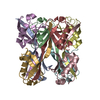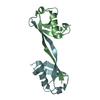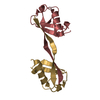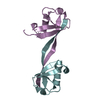+ Open data
Open data
- Basic information
Basic information
| Entry | Database: PDB / ID: 6nxl | ||||||
|---|---|---|---|---|---|---|---|
| Title | Ubiquitin binding variants | ||||||
 Components Components | Polyubiquitin-B | ||||||
 Keywords Keywords | LIGASE / APC / Ubv / Ubiquitin / Inhibitor | ||||||
| Function / homology |  Function and homology information Function and homology information | ||||||
| Biological species |  Homo sapiens (human) Homo sapiens (human) | ||||||
| Method |  X-RAY DIFFRACTION / X-RAY DIFFRACTION /  SYNCHROTRON / SYNCHROTRON /  MOLECULAR REPLACEMENT / Resolution: 2.803 Å MOLECULAR REPLACEMENT / Resolution: 2.803 Å | ||||||
 Authors Authors | Miller, D.J. / Watson, E.R. | ||||||
 Citation Citation |  Journal: Proc Natl Acad Sci U S A / Year: 2019 Journal: Proc Natl Acad Sci U S A / Year: 2019Title: Protein engineering of a ubiquitin-variant inhibitor of APC/C identifies a cryptic K48 ubiquitin chain binding site. Authors: Edmond R Watson / Christy R R Grace / Wei Zhang / Darcie J Miller / Iain F Davidson / J Rajan Prabu / Shanshan Yu / Derek L Bolhuis / Elizaveta T Kulko / Ronnald Vollrath / David Haselbach / ...Authors: Edmond R Watson / Christy R R Grace / Wei Zhang / Darcie J Miller / Iain F Davidson / J Rajan Prabu / Shanshan Yu / Derek L Bolhuis / Elizaveta T Kulko / Ronnald Vollrath / David Haselbach / Holger Stark / Jan-Michael Peters / Nicholas G Brown / Sachdev S Sidhu / Brenda A Schulman /     Abstract: Ubiquitin (Ub)-mediated proteolysis is a fundamental mechanism used by eukaryotic cells to maintain homeostasis and protein quality, and to control timing in biological processes. Two essential ...Ubiquitin (Ub)-mediated proteolysis is a fundamental mechanism used by eukaryotic cells to maintain homeostasis and protein quality, and to control timing in biological processes. Two essential aspects of Ub regulation are conjugation through E1-E2-E3 enzymatic cascades and recognition by Ub-binding domains. An emerging theme in the Ub field is that these 2 properties are often amalgamated in conjugation enzymes. In addition to covalent thioester linkage to Ub's C terminus for Ub transfer reactions, conjugation enzymes often bind noncovalently and weakly to Ub at "exosites." However, identification of such sites is typically empirical and particularly challenging in large molecular machines. Here, studying the 1.2-MDa E3 ligase anaphase-promoting complex/cyclosome (APC/C), which controls cell division and many aspects of neurobiology, we discover a method for identifying unexpected Ub-binding sites. Using a panel of Ub variants (UbVs), we identify a protein-based inhibitor that blocks Ub ligation to APC/C substrates in vitro and ex vivo. Biochemistry, NMR, and cryo-electron microscopy (cryo-EM) structurally define the UbV interaction, explain its inhibitory activity through binding the surface on the APC2 subunit that recruits the E2 enzyme UBE2C, and ultimately reveal that this APC2 surface is also a Ub-binding exosite with preference for K48-linked chains. The results provide a tool for probing APC/C activity, have implications for the coordination of K48-linked Ub chain binding by APC/C with the multistep process of substrate polyubiquitylation, and demonstrate the power of UbV technology for identifying cryptic Ub-binding sites within large multiprotein complexes. | ||||||
| History |
|
- Structure visualization
Structure visualization
| Structure viewer | Molecule:  Molmil Molmil Jmol/JSmol Jmol/JSmol |
|---|
- Downloads & links
Downloads & links
- Download
Download
| PDBx/mmCIF format |  6nxl.cif.gz 6nxl.cif.gz | 123 KB | Display |  PDBx/mmCIF format PDBx/mmCIF format |
|---|---|---|---|---|
| PDB format |  pdb6nxl.ent.gz pdb6nxl.ent.gz | 95.4 KB | Display |  PDB format PDB format |
| PDBx/mmJSON format |  6nxl.json.gz 6nxl.json.gz | Tree view |  PDBx/mmJSON format PDBx/mmJSON format | |
| Others |  Other downloads Other downloads |
-Validation report
| Summary document |  6nxl_validation.pdf.gz 6nxl_validation.pdf.gz | 467.4 KB | Display |  wwPDB validaton report wwPDB validaton report |
|---|---|---|---|---|
| Full document |  6nxl_full_validation.pdf.gz 6nxl_full_validation.pdf.gz | 470.3 KB | Display | |
| Data in XML |  6nxl_validation.xml.gz 6nxl_validation.xml.gz | 19.8 KB | Display | |
| Data in CIF |  6nxl_validation.cif.gz 6nxl_validation.cif.gz | 27.8 KB | Display | |
| Arichive directory |  https://data.pdbj.org/pub/pdb/validation_reports/nx/6nxl https://data.pdbj.org/pub/pdb/validation_reports/nx/6nxl ftp://data.pdbj.org/pub/pdb/validation_reports/nx/6nxl ftp://data.pdbj.org/pub/pdb/validation_reports/nx/6nxl | HTTPS FTP |
-Related structure data
| Related structure data |  6nxkC  6ob1C  4s1zS S: Starting model for refinement C: citing same article ( |
|---|---|
| Similar structure data |
- Links
Links
- Assembly
Assembly
| Deposited unit | 
| ||||||||
|---|---|---|---|---|---|---|---|---|---|
| 1 | 
| ||||||||
| 2 | 
| ||||||||
| 3 | 
| ||||||||
| 4 | 
| ||||||||
| Unit cell |
|
- Components
Components
| #1: Protein | Mass: 8896.072 Da / Num. of mol.: 8 Source method: isolated from a genetically manipulated source Source: (gene. exp.)  Homo sapiens (human) / Gene: UBB Homo sapiens (human) / Gene: UBBProduction host: Strain (production host): BL21(DE3)-RIL / References: UniProt: B4DV12 |
|---|
-Experimental details
-Experiment
| Experiment | Method:  X-RAY DIFFRACTION / Number of used crystals: 1 X-RAY DIFFRACTION / Number of used crystals: 1 |
|---|
- Sample preparation
Sample preparation
| Crystal | Density Matthews: 2.39 Å3/Da / Density % sol: 48.52 % |
|---|---|
| Crystal grow | Temperature: 277.15 K / Method: vapor diffusion, hanging drop Details: 0.1M Sodium Acetate pH 4.6, 0.02 M Calcium Chloride, 30% MPD, 0.1M Potassium Sodium Tartrate Tetrahydrate and 56mg/mL protein co-sized Ubv and APC2 WHB (735-C) |
-Data collection
| Diffraction | Mean temperature: 100 K / Serial crystal experiment: N |
|---|---|
| Diffraction source | Source:  SYNCHROTRON / Site: SYNCHROTRON / Site:  APS APS  / Beamline: 22-ID / Wavelength: 1 Å / Beamline: 22-ID / Wavelength: 1 Å |
| Detector | Type: MARMOSAIC 300 mm CCD / Detector: CCD / Date: Aug 14, 2015 |
| Radiation | Protocol: SINGLE WAVELENGTH / Monochromatic (M) / Laue (L): M / Scattering type: x-ray |
| Radiation wavelength | Wavelength: 1 Å / Relative weight: 1 |
| Reflection | Resolution: 2.8→30 Å / Num. obs: 15140 / % possible obs: 96.1 % / Redundancy: 3.5 % / Rmerge(I) obs: 0.084 / Rpim(I) all: 0.051 / Rrim(I) all: 0.099 / Rsym value: 0.084 / Net I/av σ(I): 14.8 / Net I/σ(I): 14.8 |
| Reflection shell | Resolution: 2.8→2.85 Å / Redundancy: 2.1 % / Rmerge(I) obs: 0.237 / Mean I/σ(I) obs: 2 / Num. unique obs: 529 / CC1/2: 0.935 / Rpim(I) all: 0.169 / Rrim(I) all: 0.293 / Rsym value: 0.237 / % possible all: 67 |
- Processing
Processing
| Software |
| |||||||||||||||||||||||||||||||||||||||||||||||||
|---|---|---|---|---|---|---|---|---|---|---|---|---|---|---|---|---|---|---|---|---|---|---|---|---|---|---|---|---|---|---|---|---|---|---|---|---|---|---|---|---|---|---|---|---|---|---|---|---|---|---|
| Refinement | Method to determine structure:  MOLECULAR REPLACEMENT MOLECULAR REPLACEMENTStarting model: 4S1Z Resolution: 2.803→29.596 Å / SU ML: 0.46 / Cross valid method: THROUGHOUT / σ(F): 1.38 / Phase error: 32.43 / Stereochemistry target values: ML
| |||||||||||||||||||||||||||||||||||||||||||||||||
| Solvent computation | Shrinkage radii: 0.9 Å / VDW probe radii: 1.11 Å / Solvent model: FLAT BULK SOLVENT MODEL | |||||||||||||||||||||||||||||||||||||||||||||||||
| Refinement step | Cycle: LAST / Resolution: 2.803→29.596 Å
| |||||||||||||||||||||||||||||||||||||||||||||||||
| Refine LS restraints |
| |||||||||||||||||||||||||||||||||||||||||||||||||
| LS refinement shell |
|
 Movie
Movie Controller
Controller












 PDBj
PDBj
